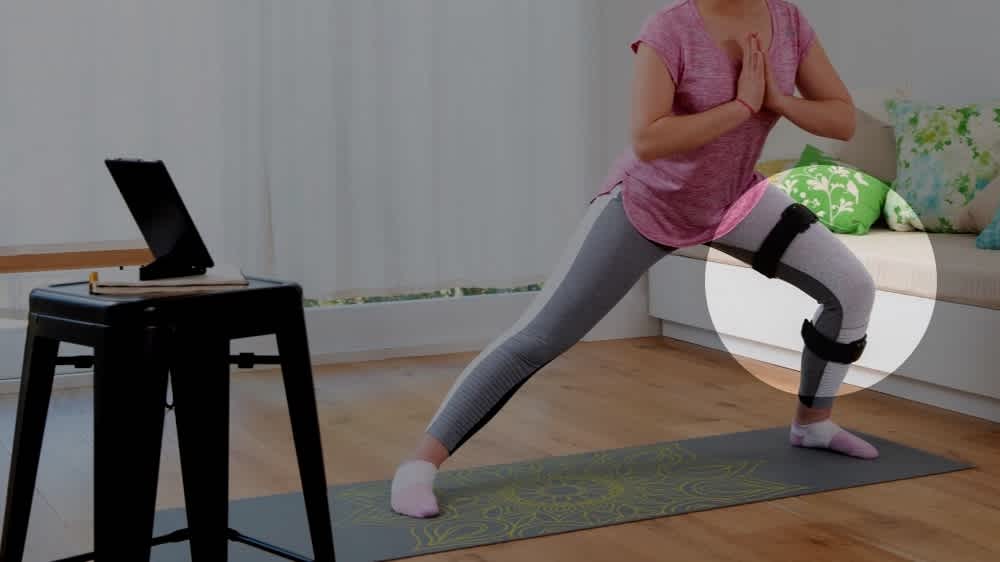25 exercise therapy sessions. Zero miles commuted.
Life gets busy, and that physical therapist referral your doctor gave you months ago gets lost under unopened letters and pushed down your growing to do list. Learn why physical therapy shouldn’t be a barrier to feeling better.
- Hinge Health Learning Center
- Articles
- 25 exercise therapy sessions. Zero miles commuted.
Reviewed by our clinical and medical experts
Sarah Lasker
Why physical therapy shouldn’t be a barrier to feeling better.
Amelia strengthened her knees on the Hinge Health knee care program. She wanted to show us how she uses her Hinge Health sensors for exercise therapy at home.
Life gets busy, and that physical therapist referral your doctor gave you months ago gets lost under unopened letters and pushed down your growing to do list. That’s what happened to Amelia, a 27 year old Account Executive at Salesforce who has struggled with knee pain for over 6 years. Like Amelia, over half of today’s workforce suffers from chronic musculoskeletal (MSK) pain. Lacking time to take off of work for weekly physical therapy appointments and information on best practice care, Amelia was not alone in her need for an accessible solution to manage her pain. Understanding the impact of this pain, is the first step to supporting employees and making a difference for the 1 in 2 people affected by an MSK disorder in a given year.
Chronic musculoskeletal pain is pain affecting the muscles, ligaments and tendons, or bones that lasts longer than 3 months. When someone suffers from this persistent type of pain, pain becomes an expected part of daily life, and they are constantly forced to compromise both work and recreational activities because of the pain. Amelia’s knee started to bother her from constant wear and tear her senior year of college. After years of pain, Amelia felt that her pain was something that she would just have to deal with, not something she could easily resolve. As a varsity sailor, she persisted through the pain because she was determined to finish her season. Then after college, the pain would continue to reappear whether she was trying to have fun hiking in the Bay Area or at work, sitting at a desk for long hours. Sometimes, Amelia’s pain would be so bad it would prevent her from sleeping, leaving her tired and unable to concentrate at work the next day. Determined not to let her pain stop her from living her life, Amelia would attend spin and yoga classes, but she knew her knees felt weak and would sometimes buckle, so feared that any sudden move on the spin bike could leave her in excruciating pain.
Taking the initiative to try and find a solution to her pain, Amelia went to her primary care doctor to get a referral for physical therapy. But she ended up never seeing a physical therapist because it was hard to find the time to take off from work and commute across the city 3 times a week. Amelia assumed that resolution just wasn’t possible right now because physical therapy couldn’t fit into her busy life. But one day, Amelia saw an email in her inbox from her employer about a new benefit offering called Hinge Health, a program that she could do in the convenience of her own home. Without high expectations, she decided to give it a try. She used wearable sensors to give her confidence that she was completing the recommended exercise therapy, she received support from a health coach to motivate her to overcome her fear of injury, and she read educational articles to learn how to effectively manage her pain.
After a few weeks of doing her exercises she started to notice that her knee no longer felt wobbly and weak, her knee was stronger. Instead of being scared that her knee would give out, she could now immerse herself into her spin classes and enjoy the workout. Amelia no longer had to compromise during daily activities because of pain.
Earlier this year, we had the opportunity to meet Amelia in San Francisco. She showed up on site, full of energy and demonstrated the lunges and squats that helped give her the strength and confidence to keep moving. Amelia needed a solution beyond physical therapy to reduce her pain and allow her to be productive at work and in her personal life. Through a combination of exercise therapy, behavioral health, and education Amelia was able to successfully complete the program. She isn’t afraid to turn up the resistance on her spin bike and she is excited for next year’s ski season, ready to ski a full day without any pain.
Employees like Amelia, need a solution that can break down the barriers to the three pillars of best practice musculoskeletal care: exercise therapy, behavioral health, and education. By understanding the barriers to recommended MSK care and how to overcome them, you can empower employees to reduce their pain and do the things they love.
Download the white paper to learn more about the impact of MSK on your workforces’ pain, productivity, and overall mental health.

